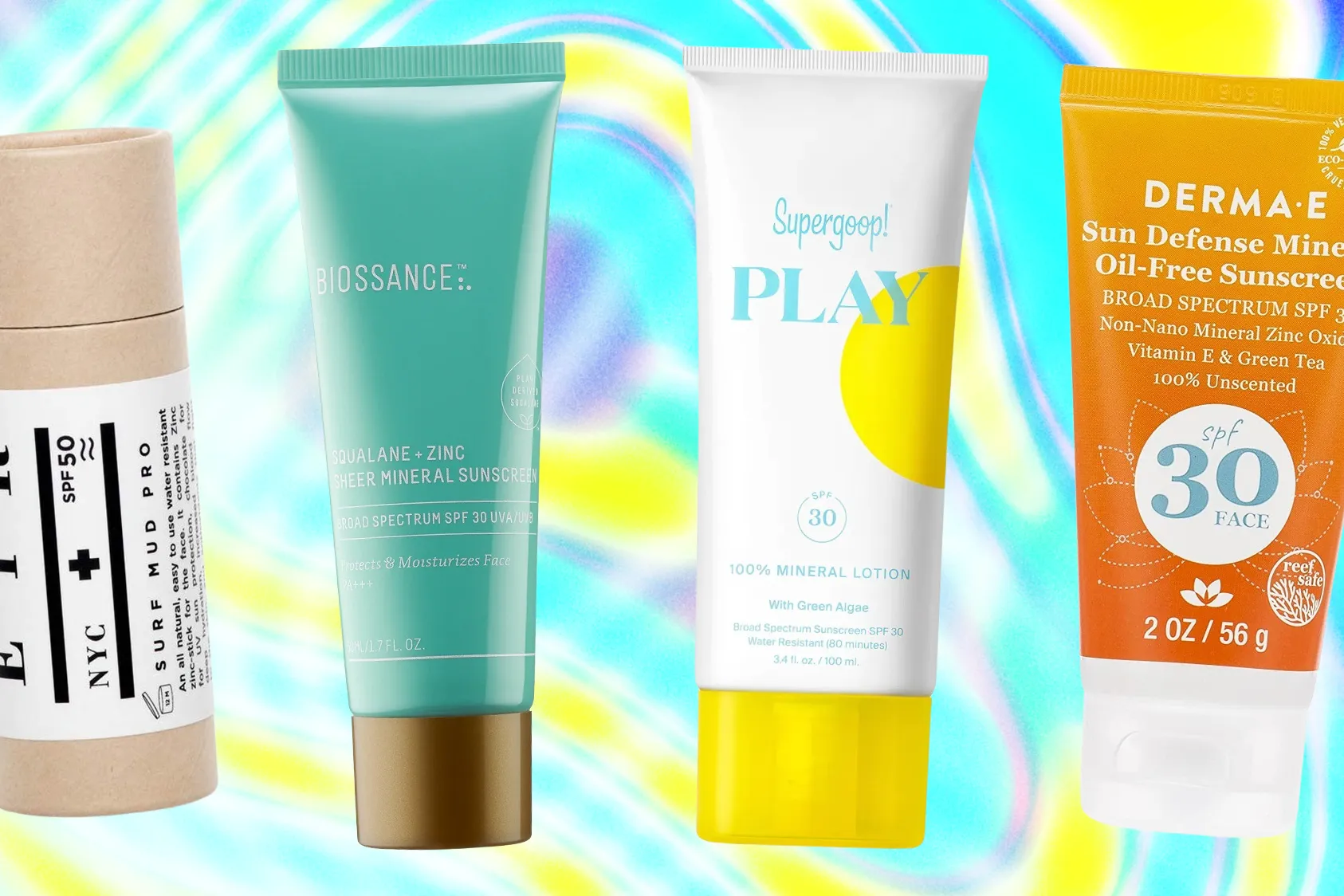When it comes to protecting your skin from the sun, sunscreen is non-negotiable. But with so many options out there, it can be confusing to decide between chemical and mineral sunscreens. Which one suits your skin? Is one better for the environment? In this detailed guide, we’ll break down everything you need to know about chemical vs mineral sunscreen so you can make the best choice for YOU.
Also Read: The 9 Best Beauty Investments I Have to Make in 2025
Table of Contents
ToggleWhat Is Sunscreen and Why Is It Important?
Sunscreen is a skincare product designed to protect your skin from harmful ultraviolet (UV) rays. These rays are divided into two types:
- UVA Rays: Cause premature aging and wrinkles.
- UVB Rays: Cause sunburns and are linked to skin cancer.
Prolonged exposure to UV rays without protection can lead to sunburn, hyperpigmentation, and even serious skin conditions like melanoma. That’s why dermatologists recommend using sunscreen every day, no matter the weather.
For more on UV rays and sun protection, check out this resource: Skin Cancer Foundation – The Importance of Sunscreen.
Chemical vs Mineral Sunscreen: The Basics
What Are Chemical Sunscreens?
Chemical sunscreens contain organic (carbon-based) ingredients such as:
- Oxybenzone
- Avobenzone
- Octinoxate
- Homosalate

These ingredients penetrate the skin to absorb UV rays, converting them into heat and releasing them from the skin.
What Are Mineral Sunscreens?
Mineral sunscreens, also called physical sunscreens, use natural minerals like:
- Zinc Oxide
- Titanium Dioxide
These minerals sit on the skin’s surface, creating a physical barrier that reflects and scatters UV rays away from the skin.

For a scientific breakdown, check this article: Chemical vs. Mineral Sunscreens: What’s the Difference?.
Also Read: How to Pick a Cleanser for Your Skin: A Complete Guide
How Do They Work?
Chemical Sunscreens
- Mechanism: Absorbs UV rays into the skin and converts them into heat.
- Texture: Lightweight and blends easily into the skin.
- Best For: Daily use under makeup or during water activities.
Mineral Sunscreens
- Mechanism: Reflects UV rays off the skin’s surface.
- Texture: May leave a white cast, especially on darker skin tones.
- Best For: Sensitive skin, children, and environmentally conscious users.
Pros and Cons: Chemical vs Mineral Sunscreens
| Feature | Chemical Sunscreen | Mineral Sunscreen |
| Protection | Absorbs UV rays | Reflects UV rays |
| Skin Sensitivity | May irritate sensitive skin | Gentle and suitable for all skin types |
| Application Time | Needs 15-20 minutes to activate | Works immediately upon application |
| Water Resistance | Often more water-resistant | May need reapplication more frequently |
| Environmental Impact | Can harm coral reefs (e.g., oxybenzone) | Eco-friendly; reef-safe options available |
| Appearance | Invisible finish | May leave a white residue |
Also Read: Best Skincare Routine for Dehydrated Skin
Choosing the Right Sunscreen for YOUR Skin
1. Sensitive Skin
Go for mineral sunscreens as they are less likely to cause irritation or allergic reactions. Look for labels like “fragrance-free” or “for sensitive skin.”
Try these options:
2. Acne-Prone Skin
Mineral sunscreens are non-comedogenic (won’t clog pores) and better suited for acne-prone skin. However, if you prefer chemical sunscreens, look for oil-free formulas.

Top picks:
3. Dry Skin
For dry skin, choose a sunscreen with hydrating ingredients like glycerin or hyaluronic acid. Both chemical and mineral options are available with moisturizing formulas.

Recommended products:
4. Darker Skin Tones
Chemical sunscreens tend to blend better without leaving a white cast. If you prefer mineral sunscreen, look for tinted options to match your skin tone.
Best picks:
Environmental Concerns: Are Sunscreens Safe for the Planet?
Some chemical sunscreen ingredients, like oxybenzone and octinoxate, can harm marine life, particularly coral reefs. Many tourist destinations, including Hawaii and Palau, have banned sunscreens containing these ingredients.
If you’re eco-conscious, look for reef-safe labels or opt for mineral sunscreens.
Learn more here: National Ocean Service – Sunscreen and Coral Reefs.
Tips for Proper Sunscreen Use
- Apply Generously: Use about a shot glass worth of sunscreen for your body and a nickel-sized amount for your face.
- Don’t Forget Hidden Areas: Cover your ears, neck, hands, and feet.
- Reapply Regularly: Every two hours or immediately after swimming or sweating.
- Check Expiry Dates: Expired sunscreen may not provide effective protection.
For more tips, read: How to Apply Sunscreen Correctly.
What Do Dermatologists Say?
Dermatologists agree that the best sunscreen is the one you’ll use consistently. While both chemical and mineral sunscreens are effective, your choice depends on your skin’s needs and personal preferences.
For more professional advice, visit: American Academy of Dermatology – Sunscreen FAQs.
Conclusion: Which Should YOU Pick?
If you have sensitive skin, are eco-conscious, or need immediate protection, mineral sunscreen might be your best bet. On the other hand, if you prefer a lightweight, invisible finish or need a water-resistant option, chemical sunscreen is the way to go.
Whichever you choose, the most important thing is to use sunscreen daily and reapply as needed. Protecting your skin is a lifelong commitment!
For more in-depth comparisons, explore these links:
- Healthline: Mineral vs. Chemical Sunscreens
- Everyday Health: Chemical vs. Mineral Sunscreen
Stay safe and enjoy the sun responsibly! 🌞
FAQs: Chemical vs. Mineral Sunscreen – Which One Should YOU Pick?
Here’s a list of commonly asked questions about chemical and mineral sunscreens to help you make an informed choice.
1. What is the key difference between chemical and mineral sunscreens?
Answer:
The main difference lies in how they protect your skin:
- Chemical Sunscreens: Absorb UV rays into the skin and convert them into heat, which is then released from the skin.
- Mineral Sunscreens: Sit on the skin’s surface and reflect or scatter UV rays away from the skin.
Chemical sunscreens tend to feel lighter and are better for daily wear under makeup, while mineral sunscreens are gentler and offer immediate protection.
2. Which sunscreen is better for sensitive skin?
Answer:
Mineral sunscreens are generally better for sensitive skin because they contain fewer irritants. Their active ingredients, zinc oxide and titanium dioxide, are less likely to cause redness or allergic reactions. Look for products labeled “fragrance-free” and “hypoallergenic” for added safety.
Chemical sunscreens, on the other hand, can sometimes cause stinging or irritation, especially if you have rosacea, eczema, or other skin conditions.
3. Are chemical sunscreens safe for children?
Answer:
For children, dermatologists usually recommend mineral sunscreens because they are less likely to irritate delicate skin. Zinc oxide and titanium dioxide are approved by the FDA for use on children under six months of age.
Chemical sunscreens may contain active ingredients like oxybenzone or avobenzone, which could cause irritation or allergic reactions in young children. Always consult your pediatrician for recommendations suitable for infants and toddlers.
4. Does mineral sunscreen leave a white cast?
Answer:
Yes, mineral sunscreens can leave a white residue on the skin due to the reflective nature of zinc oxide and titanium dioxide. This effect is more noticeable on darker skin tones.
However, many brands now offer tinted mineral sunscreens that blend more seamlessly into the skin, reducing the appearance of a white cast. Always test the product on your skin before purchasing if this is a concern.
5. Is one type of sunscreen more effective than the other?
Answer:
Both chemical and mineral sunscreens are equally effective if they are labeled broad-spectrum and have an SPF of 30 or higher. The effectiveness depends on proper application and regular reapplication.
That said:
- Mineral sunscreens work immediately after application.
- Chemical sunscreens need about 15-20 minutes to start protecting your skin.
6. Are chemical sunscreens bad for the environment?
Answer:
Some chemical sunscreens contain ingredients like oxybenzone and octinoxate, which have been shown to harm coral reefs and marine ecosystems. These chemicals can cause coral bleaching, disrupting marine biodiversity.
Many eco-conscious brands now offer reef-safe chemical sunscreens by avoiding harmful ingredients. If environmental impact is a concern, opt for mineral sunscreens, which are typically reef-safe.
Learn more: NOAA on Sunscreen and Coral Reefs.
7. How often should I reapply sunscreen?
Answer:
Reapply sunscreen every two hours, or more frequently if you are swimming, sweating, or toweling off. For mineral sunscreens, you may need to reapply more often as they can wear off faster due to physical removal.
Remember: A higher SPF does not mean you can wait longer to reapply. Sunscreen effectiveness diminishes over time regardless of SPF rating.
8. Can I use chemical and mineral sunscreens together?
Answer:
Yes, you can layer or alternate between chemical and mineral sunscreens, but there’s no significant advantage to mixing them. Combining them won’t provide “double” protection.
If you choose to layer, apply the mineral sunscreen first (as it sits on the surface) and the chemical sunscreen second (as it needs to absorb into the skin).
9. Can I use sunscreen on top of makeup?
Answer:
Yes, you can apply sunscreen over makeup. For better results:
- Use a spray sunscreen or a powder sunscreen to avoid disturbing your makeup.
- Look for lightweight, non-greasy formulas if reapplying chemical sunscreens.
Alternatively, choose a tinted sunscreen or a foundation with SPF for added convenience. Remember, SPF in makeup alone isn’t enough for complete sun protection.
10. How do I choose the right sunscreen for daily use?
Answer:
When choosing a sunscreen for daily use, consider the following factors:
- Skin Type:
- Sensitive or acne-prone skin? Go for mineral sunscreen.
- Oily skin? Pick an oil-free, mattifying formula.
- Dry skin? Look for moisturizing sunscreens with hyaluronic acid or ceramides.
- Texture:
- Lightweight textures work well for daily wear under makeup.
- Lifestyle:
- Spend time outdoors or near water? Choose a water-resistant option.
- Environmental Impact:
- If you’re eco-conscious, select reef-safe sunscreens.
For a deeper dive into choosing the right sunscreen, check this guide: Dermatologist-Approved Sunscreen Tips.
